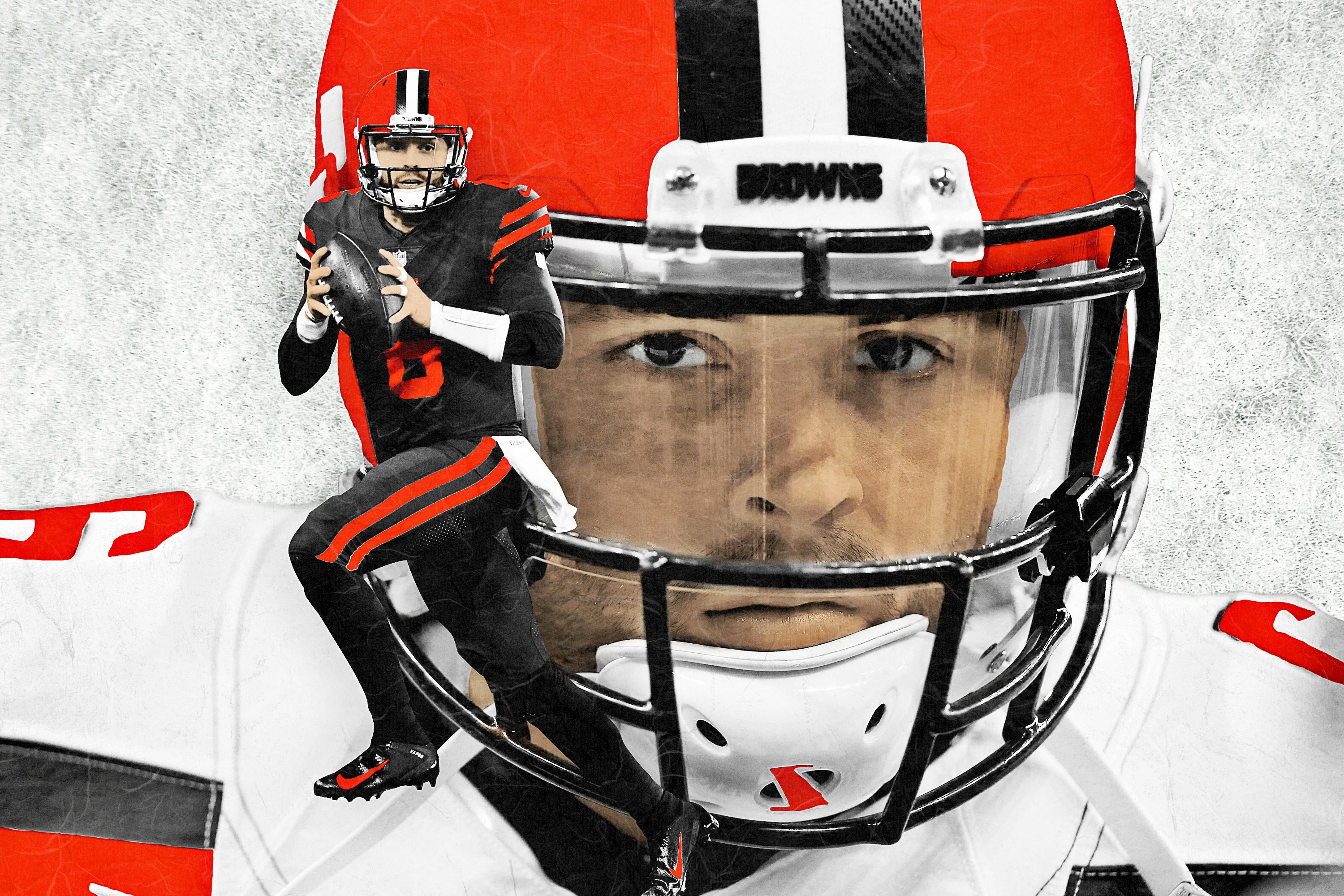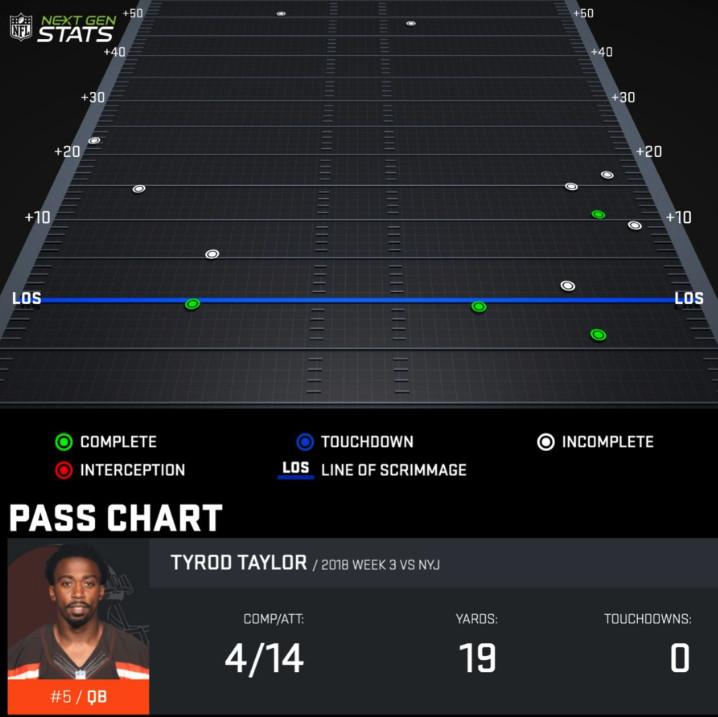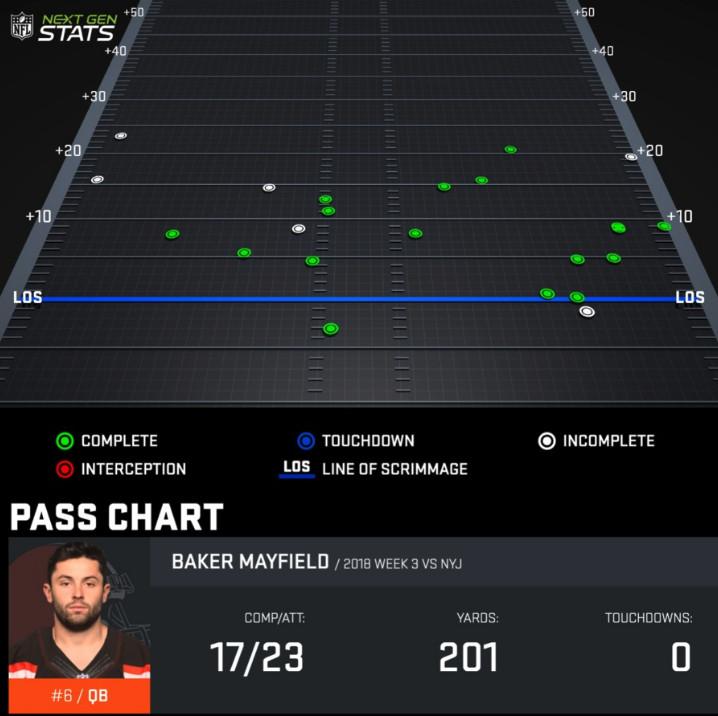
When Baker Mayfield replaced an injured Tyrod Taylor late in the first half of the Browns-Jets tilt last Thursday, it was obvious immediately that the pro game wasn’t too big for the 23-year-old rookie. With the half winding down, Mayfield calmly directed Cleveland’s no-huddle, two-minute offense and moved the ball into field goal range with completions of 14, 17, and 16 yards on his first three passes. In the second half, Mayfield led Cleveland’s offense to scores on three out of the next four drives and erased a 14-point deficit to lift the Browns to a 21-17 win. The Mayfield era in Cleveland had begun.
Mayfield seemed to revel in the pressure: He was confident and cool, then fiery when he needed to be. He spread the ball around and attacked the Jets defense. Mayfield completely changes the Browns, and his combination of accuracy and aggressiveness as a passer could unlock the offense and should boost the fantasy stock of a few of his top playmakers.
The first thing that stood out about Mayfield’s premiere was his pinpoint accuracy at all three levels of the field. He completed 17 of 23 passes for 201 yards in a little more than one half of play, and with three drops and a throwaway, finished with an adjusted completion rate of 90.9 percent, per Pro Football Focus. That’s not shabby for a first day at the office. He was poised under pressure (4-for-6, 66 yards), had no problem attacking vertically (5-for-9 on passes that went for 10-plus yards), and even made a few on-target throws on the move and out of the pocket.
For those who watched Mayfield in college, this performance didn’t come as much of a surprise. The former Heisman winner led the nation in completion percentage (70.5) and yards per attempt last year (11.5)—completely absurd—and posted a 62.5 percent adjusted accuracy rate on passes of 20-plus yards. After setting the NCAA record for passing efficiency (the college equivalent of passer rating) in 2016 (196.39), he broke his own mark in 2017 (198.92). That season, he finished second in yards (4,627) and touchdowns (43) while tossing just six picks. And if those numbers aren’t convincing enough, just watch him destroy this pre-draft accuracy challenge.
Mayfield throws with more velocity than his 6-foot-1, 215-pound frame might imply too. Ask top target Jarvis Landry, who decided he’d have to turn up the ol’ JUGS machine this week after letting one frozen-rope throw from his new quarterback sneak up on him against the Jets. Look at where the ball hits Landry, by the way.
“It got to me so quickly,” Landry said. “I dropped it because I didn’t even know how to put my hands, and before I could make the decision, the ball was on me.”
A week full of first-team reps should improve chemistry and timing between Mayfield and his top weapons, and his accurate, high-velocity throws could open things up for Cleveland’s offense. The former Sooner showed no hesitation to attack the intermediate and deep areas of the middle of the field, something that Taylor avoided both in that game and for much of the first two weeks (and most of last year for the Bills). Here’s Taylor’s passing chart from Thursday, via NFL Next Gen Stats:

Now, here’s Mayfield’s.

That contrast illustrates what the Browns offense has been missing: The ability to consistently attack the seams, stress middle-of-field defenders, and move the ball vertically downfield. As Football Outsiders noted this summer, inside-breaking routes like digs, slants, posts, and seam routes were all more efficient than traditional outside or out-breaking routes like fades, comebacks, outs, and curls in 2017, and PFF found that during the past decade, throws targeting slot receivers and tight ends produce higher expected points added (EPA) than to players lined up outside. Simply put, it’s more difficult to move the ball down the field if you avoid that huge swath of green right up the middle—and Mayfield showed no fear throwing darts into traffic in that area.
The primary beneficiary of that change is Landry, who was Mayfield’s most trusted receiver last Thursday, collecting seven of his nine targets for 91 yards from the rookie (that’s an average of 13 yards per reception, well above his 8.8 yards-per-reception average in Miami last year).
Landry was deft against both zone and man coverage and found the soft spot or created separation right when the ball arrived. Mayfield threaded the needle into tight coverage on a few big gains.
Not all of Mayfield’s throws were fastballs. He dropped back, stepped into the pocket (which drew the attention of safety Jamal Adams), and waited for Landry to come open in the second level before lofting a floater over Adams.
Late in the third quarter, Mayfield saw Landry running up the numbers and, seeing Jets safety Doug Middleton with his back turned, threw the ball up for Landry to grab.
Mayfield showed off a nice connection with tight end David Njoku, too, hitting the über-athletic big man on a couple of routes up the seams.
For good measure, he hit receiver Rashard Higgins running a vertical route out of the slot, too.
Mayfield was nearly as effective throwing to the outside as well, and stressing the Jets defense horizontally with a bevy of strong, well-placed passes toward the perimeter. Higgins caught one dart on a quick out route, and receiver Antonio Callaway, who is primarily lined up on the outside this year, was a frequent target (even though Callaway dropped that dime of a throw down the left sideline).
Mayfield worked the sideline on a few scramble-drill plays as well, and escaped the pocket to throw accurate passes on the move.
Mayfield wasn’t perfect in his first game as a pro—he did fumble the ball taking a snap and nearly threw a pick in the end zone—but he demonstrated exactly why John Dorsey and the Browns took him with the first overall pick.
Any quarterback change is going to create uncertainty in the fantasy realm, but with Cleveland’s shake-up at the position, opportunity is knocking. Previously middling or un-rosterable players like Rashard Higgins (owned in just 1 percent of Yahoo leagues) could be worth a closer look or speculative add, and in the case of a few of the principal figures in this team’s offense, huge jumps in production could be coming.
Mayfield (owned in 38 percent of Yahoo leagues) is worth an add in two-QB or SuperFlex leagues, and he may even be worth a stash in standard single-QB leagues. Callaway, now owned in just 34 percent of Yahoo leagues, is a must-add player on the waiver wire and capable of doing a whole lot more with the 10 targets he saw Thursday. Njoku, a hot preseason name who fizzled through the first two games, is certainly more relevant now. And Landry (20 catches, 278 yards, no touchdowns) could be an intriguing buy-low target with the chance to explode in a higher-octane offense.
This Browns offense, which features a quality offensive line and plenty of talent at the skill-position spots, simply needed someone better able to attack the middle of the field and unlock the potential of its top playmakers. Defenses will adjust to Mayfield’s tendencies, strengths, and weaknesses, sure, and there’s bound to be some bumps in the road for the rookie. But with more time to hone his chemistry with the first team, better absorb the offense, and gain more experience on the field, the sky’s the limit for this group. The actual scheme—offensive coordinator Todd Haley’s plays, terminology, and philosophy—may not change drastically with Mayfield under center, but the rookie already has shown how much more effectively he can harness it.

